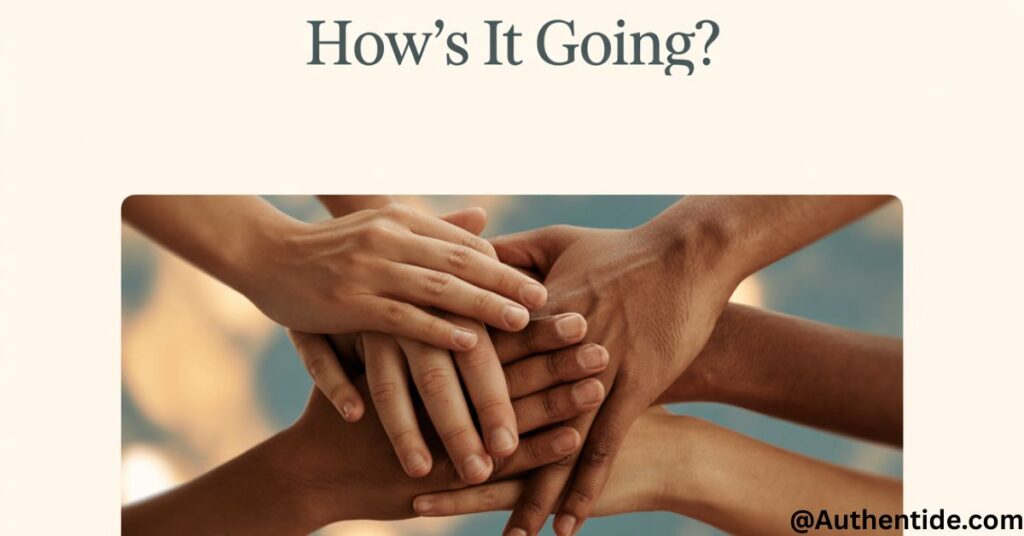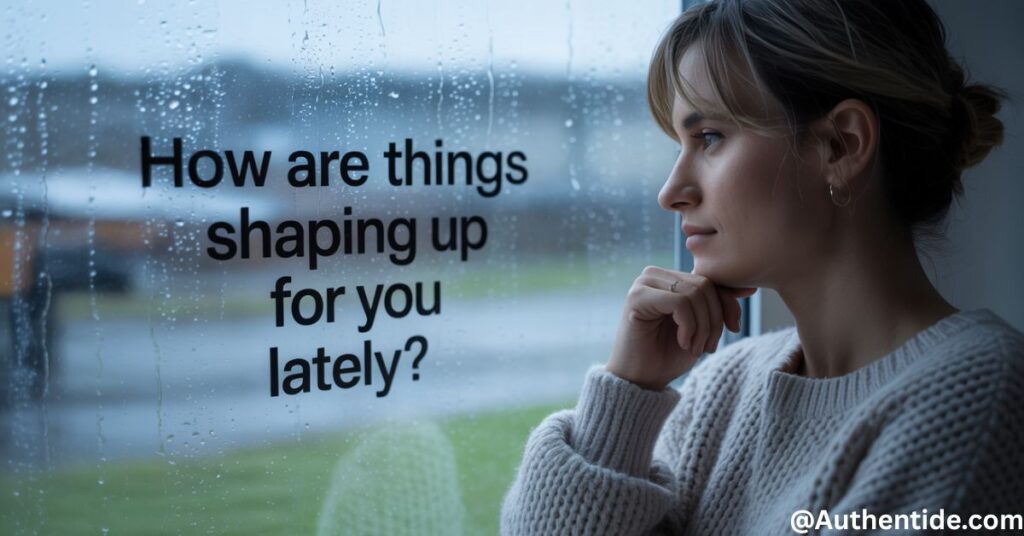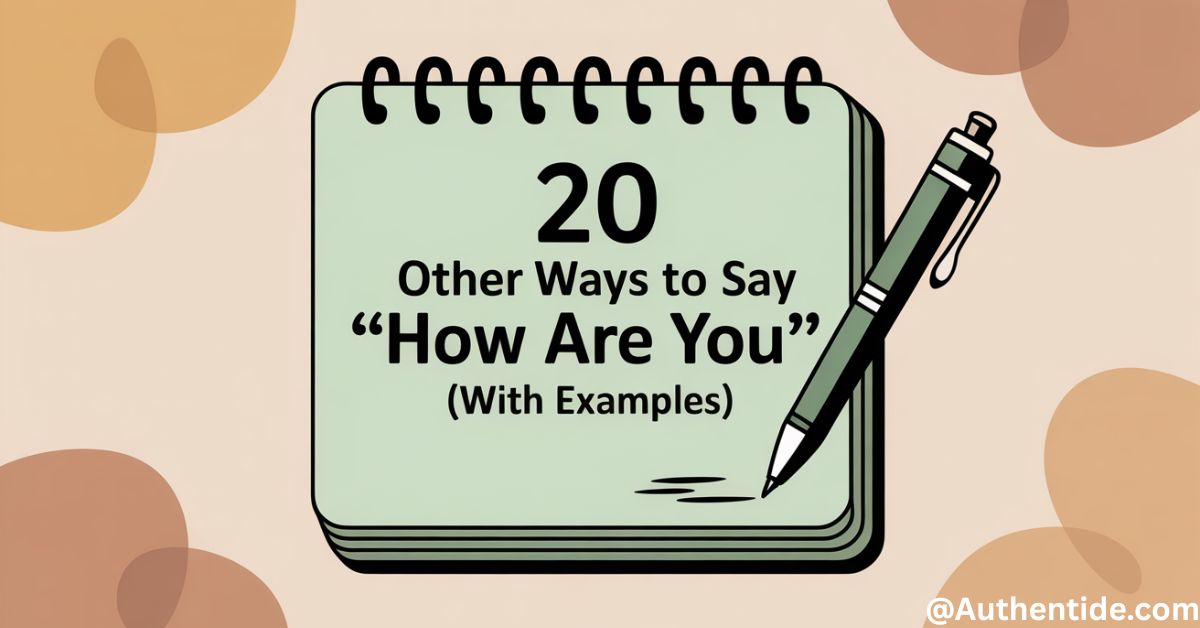How are you those three little words we toss around dozens of times daily without a second thought. They’ve become our go-to conversation starter, our verbal handshake, our way of acknowledging someone’s existence without really engaging. But what if I told you there’s a whole universe of alternatives that could transform your everyday interactions from mundane to meaningful?
The art of asking about someone’s wellbeing isn’t just about words it is about creating genuine connections. When we break free from the robotic “how are you” and choose expressions that invite real answers, we open doors to authentic conversations that might otherwise remain closed. Whether you’re crafting an email to a colleague, texting an old friend, or greeting someone at a networking event, your choice of words can make all the difference.
What to Say Instead of “How Are You”
- How’s it going? – Casual and versatile for everyday situations
- What’s new? – Invites updates without focusing on emotional state
- What’s up? – Casual and friendly for people you know well
- How have you been? – Perfect for reconnecting after time apart
- What’s going on? – Can refer to current activities or life in general
- How are things shaping up for you lately? – Acknowledges life as a process
- What’s been keeping you busy? – Focuses on activities rather than feelings
- How are you feeling today? – More specific and immediate than generic version
- What’s made you smile recently? – Positive framing invites sharing good news
- How’s life treating you? – Makes it easier to discuss challenges
- How’s the new job treating you? – Acknowledges specific life changes
- How’s your [specific project/challenge] coming along? – Shows you remember what matters to them
- How are you holding up? – Compassionate for difficult times
- How’s your day/week been so far? – Time-bound and manageable
- What’s on your mind lately? – Open-ended and gives freedom to share
- I hope this message finds you well – Formal but warm for professional emails
- How are things in [their location]? – Personalizes by acknowledging where they are
- I’ve been thinking about you and wondered… – Shows genuine care
- Checking in to see how you’re navigating… – Acknowledges specific circumstances
- I’d love to hear what’s new in your world – Invites them to share what they consider noteworthy
Why We Need Alternatives to “How Are You”
We’ve all been there someone asks “how are you,” and before they’ve even finished the question, you’ve already replied with “fine, thanks” or “good, and you?” It’s become so automatic that it barely registers as communication anymore. The problem isn’t with the sentiment behind how are you it is with how overused it’s become.
Research suggests that meaningful social connections significantly impact our mental and physical health. Yet, our most common greeting has become a hollow exchange, a verbal tic rather than a genuine inquiry. By exploring how are you in different ways, we can revitalize our daily interactions and create space for authentic connection.
Think about the last time someone asked you about your wellbeing in a way that made you pause and actually consider your answer. Chances are, they did not use the standard “how are you?” They probably asked something more specific, more thoughtful, or more attuned to your particular circumstances.
Quick and Casual Alternatives
Sometimes you need a greeting that’s breezy but still shows you care. These options are perfect for passing conversations, quick text messages, or when you want to keep things light.
1. “How’s it going?”

This classic how are you alternative works in almost any casual setting. It’s friendly without demanding an in-depth response.
Example: Walking into a meeting and nodding to your colleague Sam: “Hey, how’s it going today? Ready for the presentation?”
2. “What’s new?”
This invites the other person to share updates without the pressure of discussing their emotional state.
Example: In an email to an old classmate:
Subject: Long time no chat!
Hi **Jessica**,
What's new in your world? I just finished that certification program I mentioned last time we spoke.
Looking forward to catching up,
[Your name]
3. “What’s up?”
Casual and versatile, this works especially well with people you know fairly well.
Example: Text message to a friend:
What's up? Free for coffee this weekend? The new place on Main Street has amazing pastries.
4. “How have you been?”
This suggests a bit more time has passed since you last connected, making it perfect for reconnecting with someone.
Example: Running into a former colleague at a conference: “Michael! How have you been? It’s been ages since the Anderson project wrapped up.”
5. “What’s going on?”
This can refer to either their life in general or what they’re currently doing, making it versatile.
Example: Video call opening with a team member: “Hey Taylor, what’s going on? Did you get a chance to look at those numbers I sent over?”
More Thoughtful Check-Ins
When you want to show genuine interest and open the door to a deeper conversation, try these how are you in other words options that invite more than a one-word response.
6. “How are things shaping up for you lately?”

This acknowledges that life is a process and invites reflection on recent developments.
Example: Email to a business contact:
Subject: Quarterly check-in
Hi **Natasha**,
How are things shaping up for you lately? I've been thinking about our discussion regarding market expansion and wanted to follow up.
Best regards,
[Your name]
7. “What’s been keeping you busy?”
This focuses on activities rather than feelings, which some people find easier to discuss.
Example: Starting a conversation at a networking event: “So, David, what’s been keeping you busy these days? I saw your company announced that new product line.”
8. “How are you feeling today?”
Adding “today” makes this how are you different ways option more immediate and specific than the generic version.
Example: Message to someone who’s been unwell:
How are you feeling today? Better than yesterday, I hope? Let me know if you need anything dropped off.
9. “What’s made you smile recently?”
This positive framing invites sharing of good news or pleasant moments.
Example: Catching up with a friend over lunch: “Before we get into everything else, tell me – what’s made you smile recently? I could use some good news.”
10. “How’s life treating you?”
This personifies “life” as an actor, which can make it easier for people to discuss challenges without feeling like they’re complaining.
Example: Beginning a phone call with a relative: “Hi Uncle Paul, how’s life treating you these days? We’ve missed seeing you at family gatherings.”
For Specific Situations
Sometimes the best conversation starter is one that acknowledges the specific context or recent events in someone’s life.
11. “How’s the new job treating you?”
When someone has started something new, acknowledging it shows you remember and care about their life changes.
Example: Text to a friend who recently changed careers:
How's the new job treating you? Have they figured out how lucky they are to have you yet? 😊
12. “How’s your [specific project/challenge] coming along?”
!["How's your [specific project/challenge] coming along?"](https://authentide.com/wp-content/uploads/2025/05/Hows-your-specific-projectchallenge-coming-along-1024x536.jpg)
This shows you remember what matters to them and invites them to share progress or setbacks.
Example: Email to a colleague:
Subject: Checking in
Hi **Marcus**,
How's your website redesign coming along? I remember you mentioning some challenges with the developer last time we spoke.
Regards,
[Your name]
13. “How are you holding up?”
Perfect for when someone is going through a difficult time, this acknowledges their struggle without requiring them to pretend everything is fine.
Example: Card to someone experiencing grief:
Dear **Elena**,
I've been thinking of you often. How are you holding up? I'm here whenever you need to talk, or just sit quietly together.
With love,
[Your name]
14. “How’s your day/week been so far?”
This time-bound question feels more manageable than asking about their life in general.
Example: Starting a Zoom meeting: “Before we dive into the agenda, how’s everyone’s week been so far? Anything exciting happening?”
15. “What’s on your mind lately?”
This open-ended question gives them freedom to share whatever they choose – whether personal or professional.
Example: Coffee date with a mentor: “Thanks for making time to meet, Dr. Chen. What’s been on your mind lately? Any interesting new research catching your attention?”
For Written Communication
In emails and messages, certain language tools and phrases can help you stand out from the sea of generic greetings.
16. “I hope this message finds you well”

A formal but warm opening for professional emails.
Example: Business email:
Subject: Proposal for Q3 Marketing Campaign
Dear **Ms. Rivera**,
I hope this message finds you well. I've attached our team's proposal for the upcoming campaign we discussed last week.
Sincerely,
[Your name]
17. “How are things in [their location]?”
Acknowledging someone’s location makes your message more personal and can spark conversation about local events or weather.
Example: Email to a client in another city:
Hi **Thomas**,
How are things in Chicago? I heard you're having an unusually warm fall this year. We're still battling rain here in Seattle!
Regarding your project timeline...
18. “I’ve been thinking about you and wondered…”
This shows genuine care and personal investment in their wellbeing.
Example: Message to a friend going through changes:
Hey **Priya**,
I've been thinking about you and wondered how you're adjusting to your new apartment. Have you met any neighbors yet?
Would love to see pictures when you're settled!
19. “Checking in to see how you’re navigating…”
This acknowledges specific circumstances while giving them space to share as much or as little as they wish.
Example: Email to a colleague during a busy period:
Subject: Quick check-in
Hi **Jordan**,
Just checking in to see how you're navigating the end-of-quarter rush. Is there anything I can help with from my end?
Best,
[Your name]
20. “I’d love to hear what’s new in your world”

This invites them to share whatever they consider noteworthy, whether personal or professional.
Example: Message to reconnect with someone:
Hi **Alex**,
It's been too long since we caught up properly. I'd love to hear what's new in your world! I've just started taking pottery classes and am creating the world's most lopsided mugs.
Any chance you're free for a phone call next week?
Pro Tips for Making Your Greetings Count
The most important paragraph in this article might just be this one – because it’s not just about finding how are you synonyms, but about transforming how we connect with others. The words we choose are just one component of meaningful communication. Here are some pro tips to elevate your check-ins from forgettable to impactful:
- Match your tone to your relationship – The way you ask your boss about their wellbeing should differ from how you ask your best friend. Consider your relationship and the appropriate level of formality or intimacy.
- Follow up on previous conversations – If someone mentioned an upcoming event or challenge last time you spoke, reference it specifically. “How did your presentation go?” shows you were truly listening.
- Be sincere – Only ask questions you genuinely want the answers to. People can sense when you’re asking out of obligation rather than interest.
- Give them an easy out – For busy contacts, pair your question with permission to keep it brief: “How’s everything going? I know you’re swamped, so the short version is fine!”
- Share something first – Sometimes people feel more comfortable opening up if you go first: “I’ve had a chaotic week trying to meet this deadline. How have things been on your end?”
Why This Matters
In a world where digital communication often replaces face-to-face interaction, our choice of words becomes even more significant. Those three little words how are you can be transformed from a throwaway common greeting into a genuine invitation to connect.
By expanding your repertoire of ways to check in with others, you’re not just polishing your communication skills you are creating space for authenticity in your relationships. Whether in professional networking, maintaining friendships, or deepening family bonds, these alternatives can help you break through the autopilot exchanges that often characterize our interactions.
Frequently Asked Question
How do you say “how are you” in cute ways?
- How’s my favorite person doing today? – Sweet and affectionate
- What’s cooking, good looking? – Playful with a touch of flirtation
- How’s that beautiful heart of yours? – Tender and caring
- What’s the haps with my favorite human? – Quirky and endearing
- How’s your day treating you, sunshine? – Warm with a cute nickname
- What’s the scoop in your world, cutie? – Casual with a sweet touch
- How’s that smile of yours today? – Focuses on something positive
- What kind of wonderful are you today? – Assumes they’re doing well
- How’s your sparkly self doing? – Playful and cheerful
- What adventures have you been up to, my dear? – Curious and affectionate
How to ask how are you in different ways flirty
- How’s the most attractive person in my contacts doing today? – Bold but playful
- What’s new in your gorgeous world? – Subtle compliment while checking in
- How’s your day going, handsome/beautiful? – Classic with a flattering touch
- What’s been on your mind lately… besides me, of course? – Playfully confident
- How are those stunning eyes of yours seeing the world today? – Specific compliment
- What kind of trouble are you getting into without me? – Suggestive but light
- How’s life treating my favorite distraction? – Implies they’re on your mind
- What would make your day even better… besides hearing from me? – Cheeky but sweet
- How’s the person I can’t stop thinking about? – Direct but not overwhelming
- What’s new with the star of my daydreams? – Romantic without being too intense
How do you say hey in a flirty way?
- Well hello there, gorgeous – Classic with immediate flattery
- Look who just brightened my day – Suggests seeing them makes you happy
- There’s that smile I’ve been thinking about – Personal and slightly intimate
- Fancy running into you here – Playful even when it’s not coincidental
- Hey you, I was just thinking about you – Shows they’re on your mind
- Well aren’t you a sight for sore eyes – Traditional with a complimentary edge
- Hey stranger, miss me? – Playful and assumes mutual interest
- There’s my favorite person – Warm with subtle flirtation
- Hey trouble – Short, playful, and suggests excitement
- I was hoping I’d hear from you today – Shows anticipation and interest
- Hey handsome/beautiful, what’s your day looking like? – Direct compliment with follow-up
- Hey you… yes, you with the amazing smile – Specific and personal
- Well hello… aren’t I lucky today? – Suggests talking to them is a treat
Conclusion
Breaking free from the how are you rut doesn’t just refresh your conversations it transforms your connections. The twenty alternatives we have explored offer more than just how are you in other words; they provide doorways to deeper, more authentic relationships in every sphere of your life.
Whether you are shooting off a quick text, crafting a thoughtful email, or navigating a difficult conversation, these alternatives give you the verbal tools to show genuine interest and create space for meaningful exchange. In our increasingly digital world, where so many interactions feel hollow and automated, these small shifts in language can make a remarkable difference.

Your go-to place for smart synonyms and celebrity updates. Muhammad Hassan Abid is dedicated to creating useful, engaging content that informs, inspires, and truly serves your curiosity

